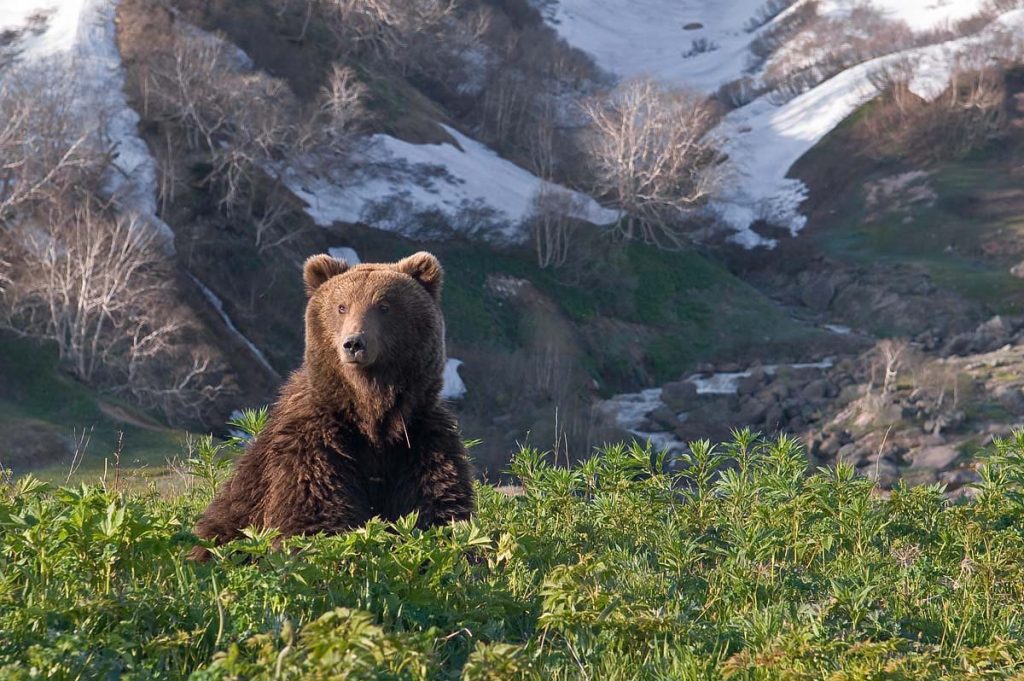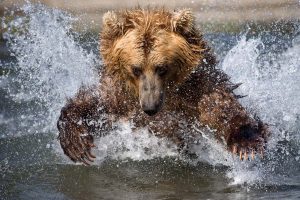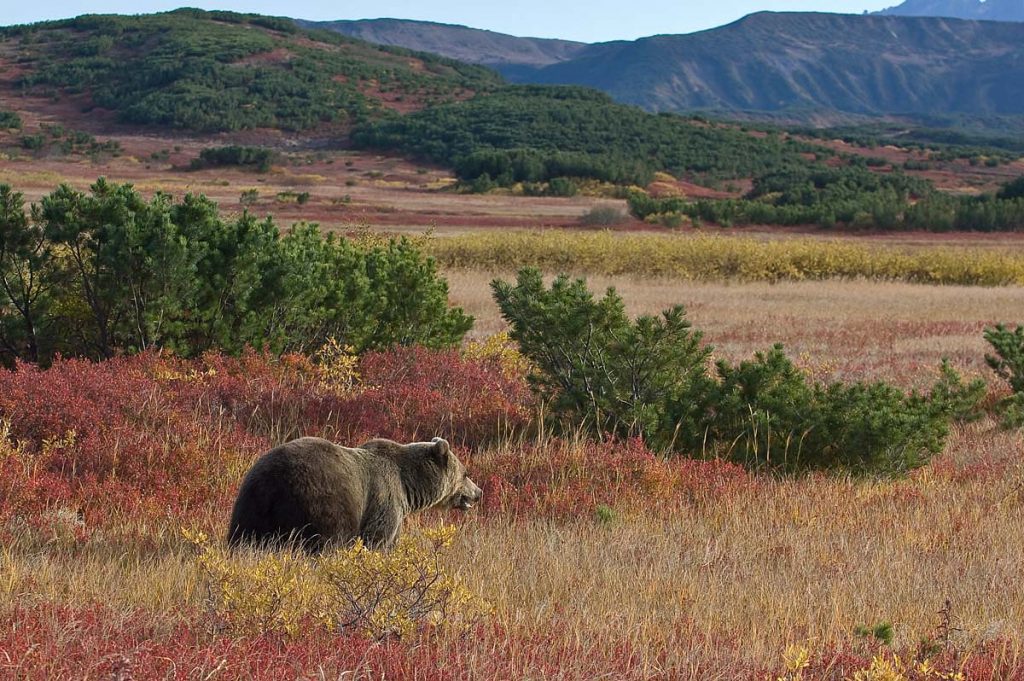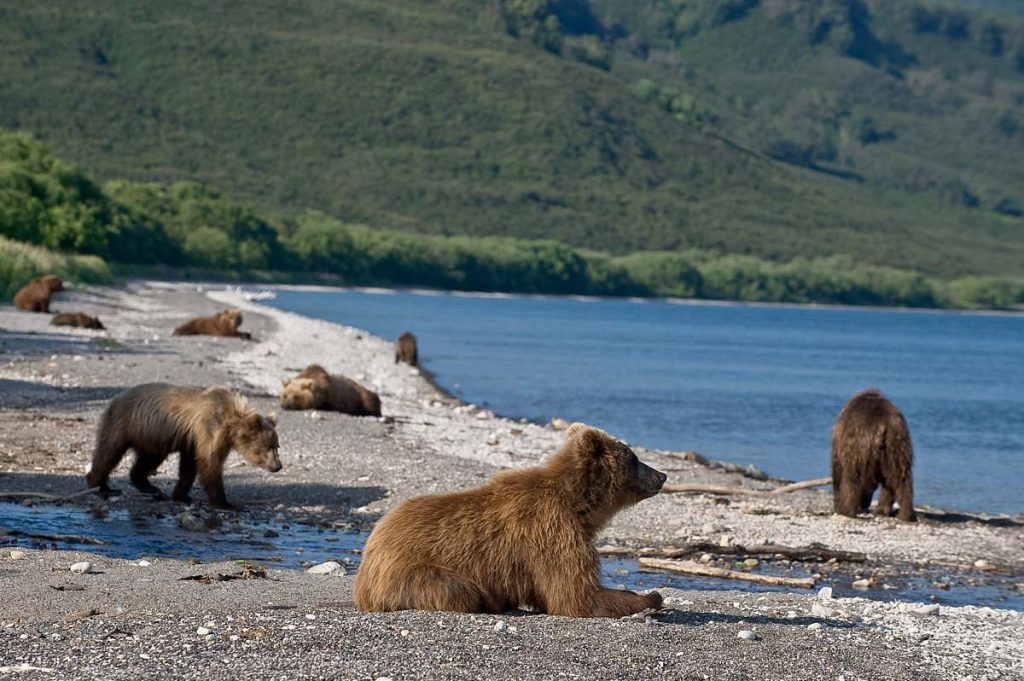 Kamchatka brown bear is one of the biggest bears on the planet. Kamchatka is one of the few places around the world where this wild animal is able to live freely because of the pristine environment.
Kamchatka brown bear is one of the biggest bears on the planet. Kamchatka is one of the few places around the world where this wild animal is able to live freely because of the pristine environment.
According to the bear population assessment, there are more 20,000 species on the peninsula. It means that every sixth brown bear in Russia dwells in Kamchatka. It is 5% of the bear population on the planet or 15% of all bears in Russia.
Most of the bears inhabit the area of Kuril Lake in Kamchatka. According to the aviation assessment, up to one thousand bears gather in this area during salmon spawning.
Kamchatka brown bears inhabit all the territory of the peninsula except highlands and swamplands. The total area of bear inhabitants reaches 460,000 km 2, which is 95% of the territory of the peninsula.
Brown bears populate the bushes of Siberian Dwarf pine and alder, the coniferous forests and birch trees. Their next preferences of habitat are plain and mountain tundra, sparse growth, and seaside lowlands.
For brown bears the food availability and spots for dens are the main criteria for choosing a habitat.
 Bears have seasonal migrations that might spread over thousand kilometers. These migrations have to do with the search of spots for winter hibernation (sleep). Bears migrate along the old trails that can obviously be seen on the open grounds and along the riverbanks.
Bears have seasonal migrations that might spread over thousand kilometers. These migrations have to do with the search of spots for winter hibernation (sleep). Bears migrate along the old trails that can obviously be seen on the open grounds and along the riverbanks.
Kamchatka brown bear is the largest one among brown bears and one of the biggest terrestrial predator with the average weight 300 kg. According to some researches, the heaviest registered specie of the adult brown bear in this region was 650 kg. Yet, the male bears can weigh up to 700 kg during the intensive feed season.
As being omnivores, bears have to survive, as the peninsula is an unstable feed environment for them. It explains the vast territory of the bear habitat.
The main feed for bears is fish, mostly salmon. The main way of obtaining food is bear fishing. Once a year, hordes of bears gather by the lakes and rivers, where a lot of fish is coming for spawning. Bears are good swimmers and are able to cross a river of width 1km. Kamchatka bears are as good at fishing as American ones from Alaska and British Columbia. They can eat up to 100 kg of salmon daily.
However, the rivers are not always an abundance of fish. In this case, bears eat the only available food – berry and nut plants. There are more than 100 kinds of plants in their diet.
 Bears can eat different food. Some of them eat only plants. Some of them can even eat wastes and animal remains. Others eat oath and dry dog food. If a whale happens to be washed on the shore, tens of bears can get together to obtain food.
Bears can eat different food. Some of them eat only plants. Some of them can even eat wastes and animal remains. Others eat oath and dry dog food. If a whale happens to be washed on the shore, tens of bears can get together to obtain food.
Kamchatka bears intensively gain weight during summer-fall season from August to September. They consume up to 40,000 calories and gain 1,5 kg daily.
After the winter hibernation, bears are starving. The hungry bears can attack the first prey they face, from small animals to big ones. They are eager to restore the fat that was digested during a winter sleep.
Bears are distinguished for their rare curiosity, excellent long-term memory, impeccable orientation in their surroundings, and gracious plastic of movements.
As for Kamchatka brown bears, they are characterized by an amazing strength; therefore, they are a great danger for people and other animals. Despite their huge size, they have an instant reaction and amazing physical endurance.
Brown bears have no rivals in their habitat. Once in a while, a pack of wolves might hunt a bear. Yet, they are able to do it if a bear is under distress. Also, these predators can feed on each other.
Kamchatka bears grow and gain weight all their life span. The age periods they gain most of their weight are 9-12, 25-35, and up to 40 years old. However, age and weight are not always connected. Some species happened to be 35 years old with the weight not more than 200 kilograms.
 There are few differences between male and female bears. A female is typically 1/3 smaller than a male. Yet, there are females in some bear populations that are a perfect fit to males in terms of their sizes and appearances. These species are called “matuhy”.
There are few differences between male and female bears. A female is typically 1/3 smaller than a male. Yet, there are females in some bear populations that are a perfect fit to males in terms of their sizes and appearances. These species are called “matuhy”.
Brown bears’ fur is not always brown. The fur color may vary from light shades to dark-brown. There are also black species. The cubs are distinguished for their white ‘collars” that appear during their first years of lives.
Brown bears have huge claws. The front paw claws are longer than back paw claws and might grow as long as 12-13 centimeters. The claws color might vary from light to black. The paw impressions as well as the size of calluses may tell about a bear’s age and size. For instance, the toddler cubs have 7-8 centimeters; 2-3 year old cubs have 10-12 centimeters; adult females have 14-17 centimeters, and adult males have 17-24 centimeters and even more. Brown bears can run with the same speed as a horse. Although, their endurance is not as strong as horses, they are able to easily run up to 100 kilometers daily. Besides, brown bears can climb rocks and walk along the narrow trails where the mountain sheep walk.
As Kamchatka brown bears are included into Convention SITES, it is necessary to obtain a permission at the SITES office in Moscow in order to take trophies, such as bearskin, souvenirs made of teeth, bones, and fur, outside the territory of the Russian Federation.
